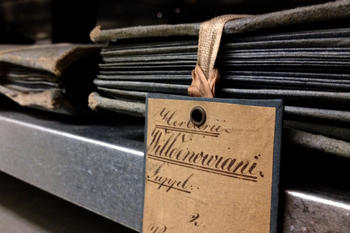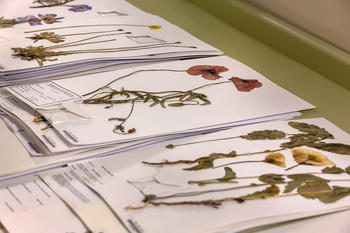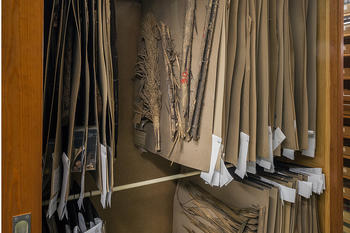Getting Back to the Roots
The Botanic Garden and Botanical Museum explore the history of collections in Berlin as part of a research alliance.
Mar 02, 2016
Collected history: The Willdenow Herbarium encompasses nearly 40,000 dried plant specimens. Some of them come from Alexander von Humboldt’s expedition in the Americas.
Image Credit: T. Geisler/BGBM
The museum has a collection of plants.
Image Credit: A. Obermüller
Larger herbarium records are kept in cabinets.
Image Credit: A. Obermüller
The Botanic Garden in Berlin’s Dahlem district is known for its rare and exotic plants, such as titan arum (Amorphophallus titanum), the world’s largest flower, which blooms only every couple of years, with a meters-tall inflorescence – and a distinctive odor of carrion, which has also earned it the name “corpse flower.”
Less well known is the fact that the Königin-Luise-Straße entrance is home to just as rare a jewel: the Botanical Museum, which opened in 1906. “This is the only museum of its kind anywhere in Europe,” says Patricia Rahemipour. “Most botanical museums are a subdivision of a museum of natural history,” explains Rahemipour, who has a doctorate in history and has just taken on responsibility for heading the knowledge communication unit for the Botanical Museum as well. “Here the outdoor grounds, museum, and research activities all tie in together in a unique way,” she says.
As a scholar of prehistory, Rahemipour herself is a rare breed among the botanists at the facility. That being the case, she felt it was necessary to explore the history of the Botanic Garden as well, since it has always been closely associated with political and social themes.
The Fate of the Botanic Garden Is Closely Linked to World History
One of the Botanic Garden’s predecessor institutions was the herb garden maintained by the court pharmacy at Berlin’s Stadtschloss (city palace) in the 16th century, and another was the kitchen gardens of Schöneberg – the site of the present-day Kleist Park – whose expansion was ordered by Prince-Elector Friedrich Wilhelm von Brandenburg in the late 17th century. The garden experienced its first heyday there in the 19th century. The extensive collections compiled by botanist Carl Ludwig Willdenow, academic instructor to the young Alexander von Humboldt, were the origins of first the royal herbarium and then the Botanical Museum.
Around the turn of the century, the Schöneberg facility came to feel a bit cramped. The institution moved to Dahlem, where the plan was to create “a German Oxford, right next door to Berlin,” as Thomas Borsch, the director of the Botanic Garden and Botanical Museum, explains. The “Central Botanical Body for the German Colonies” (Botanische Zentralstelle für die deutschen Kolonien) was also formed around the same time. Its mission, modeled on the work done for the British Empire at the Royal Botanic Gardens at Kew, was to establish botanical gardens and research institutions for crops in the German colonies.
World history literally collided with the fate of the Botanic Garden in 1943: A bomb hit the museum, destroying most of the collection. Luckily, one major treasure was saved: the Willdenow Herbarium. It encompassed folders containing about 38,000 herbarium records representing more than 20,000 species, including more than 3,000 dried plants that Alexander von Humboldt had collected on his expedition in the Americas from 1799 to 1804.
Many of them are what are known as type specimens – the original botanical basis for the first scientific description of a particular species. The collection is now also the starting point for research expeditions of a different kind: The goal of a new research alliance initiated by the Botanic Garden and Botanical Museum is to study the history of institutions in Berlin that are based on collections. Scholars of the humanities and natural scientists from 13 major institutions in Berlin – from the various institutions run by the Prussian Cultural Heritage Foundation to the Museum für Naturkunde and the German Historical Museum – are all involved in the project.
“The act of collecting is being considered as a historical event, and no longer as a purely scientific or academic activity,” Rahemipour says. Instead, the researchers aim to explore the scientific, academic, cultural, and political contexts and the academic and scientific networks that have shaped the collections. Interdisciplinary cooperation is the only way to accomplish this. This also makes it possible to take account of the various levels of meaning in the objects themselves, she says, leading visitors into the “Ancient Egypt Room” of the Botanical Museum. The room exhibits the remains of plants found in the tombs of Egyptian pharaohs: dried garlands of flowers and grapevines, but also pieces of clothing and mats woven from plant fibers.
This kind of find not only allows scholars to draw conclusions about what kinds of plants grew in the area at the time, but also points to burial rites and everyday life in ancient Egypt. And the objects themselves have also become a part of institutional history, since they were collected in the 19th century by Georg Schweinfurth. “Other places put ‘African explorer’ next to his name; we call him a botanist. It’s all a question of perspective,” says Rahemipour. To her, botany is full of interdisciplinary cross-references.
To compare a plant specimen with a 200-year-old type specimen, researchers have to not only be able to decipher old manuscripts, but also know that the site where the specimen was found, for example “Kaiser-Wilhelms-Land,” is in present-day New Guinea. And they should not be confused to find a specimen bearing the signature of Adelbert von Chamisso. The poet was also a botanist and one of the first custodians at the herbarium in Schöneberg.
As for how interdisciplinary networks were at the time, Willdenow’s “Album Amicorum,” which is archived at the Botanical Museum, offers ample evidence. “This album is a kind of predecessor of what we might think of as autograph books today,” Rahemipour explains. “But it was also used as a reference when a person was applying for a position or requesting funding for an expedition,” she adds.
Page after page, the book represents a kind of “who’s who” of the Prussian academic and research elite, decorated with miniatures, paper cutouts, and quotes. Rahemipour hopes that these kinds of albums, several of which are scattered across the Berlin collections, will help her trace the academic and scientific networks that existed at the time in detail at some point. “After all, as an institution, you have to know your past, if you want to raise your profile for the future,” she says.
This text originally appeared in German on Februar 13, 2016, in the Tagesspiegel newspaper supplement published by Freie Universität.



